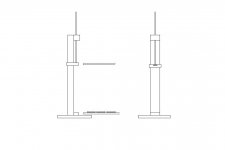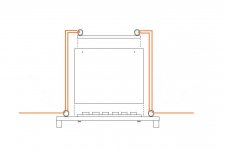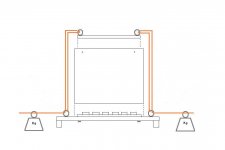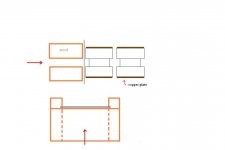I've had mixed results with cyanoacrylate adhesives and neo magnets. I devised an application with small cylindrical magnets that required a conical pole piece. Securing the pole piece with cyanoacrylate did work acceptably, if I roughened the plated surface with emery, and cleaned to remove any residues. This was good enough for that application, but the parts could be separated with relative ease.
Ed
Ed
One way to make a tool fore assembling
Two is needed, one fore each end
Its not too complicated
Need to be changed/modified a bit fore joining the two assembled magnet systems
At this point theres exstreme power to be handled
Theres a total of 20 magnets involved fore each speaker
Each magnet have a pullforce of 100lbs
That a 2000lbs of pullforce
Man, that means that this thing could lift a small car
Thats pretty dammed crazy
Might have to update my welding, before building the tool
Glue is still to be considered
Maybe silicone
Its able to hold very big aquariums together
But maybe dont give the best metal-to-metal contact
If thats important at all
Two is needed, one fore each end
Its not too complicated
Need to be changed/modified a bit fore joining the two assembled magnet systems
At this point theres exstreme power to be handled
Theres a total of 20 magnets involved fore each speaker
Each magnet have a pullforce of 100lbs
That a 2000lbs of pullforce
Man, that means that this thing could lift a small car
Thats pretty dammed crazy
Might have to update my welding, before building the tool
Glue is still to be considered
Maybe silicone
Its able to hold very big aquariums together
But maybe dont give the best metal-to-metal contact
If thats important at all
Attachments
New simpler tool
Im grown up by the sea with sailing and ropes
I know that its easy to control exstreme power with a rope, if done right
So I thought, why not
I also reconsidered my choise of magnets
I know that a row of magnets dont like to get too close together
They may spin and act like crazy
Though, I would expect that these powerful magnets will hold on to the iron quite well, but not really sure
I have also just read that the neo magnets may loose their power over time, if place with same pole very close together 🙄
Some means of fixing the magnets while glued on to the iron may be needed
Using iron poles, why not let the iron do the work
Im sure its equally good with less magnet, and some distance between them
But instead use the best there is
Looked at some 2" x 1" x 3/4", pulling 145lbs 😀
Im sure that if two magnets should clash together by accident, it will be impossible to depart them again
So everything possible should be done to avoid that
A piece of wooden plate might do the trick
Picture shows first step assembling each magnets section
A wooden box is used to fix the poleplates during assembling
Next step with assembling the two magnet systems is almost the same
Im grown up by the sea with sailing and ropes
I know that its easy to control exstreme power with a rope, if done right
So I thought, why not
I also reconsidered my choise of magnets
I know that a row of magnets dont like to get too close together
They may spin and act like crazy
Though, I would expect that these powerful magnets will hold on to the iron quite well, but not really sure
I have also just read that the neo magnets may loose their power over time, if place with same pole very close together 🙄
Some means of fixing the magnets while glued on to the iron may be needed
Using iron poles, why not let the iron do the work
Im sure its equally good with less magnet, and some distance between them
But instead use the best there is
Looked at some 2" x 1" x 3/4", pulling 145lbs 😀
Im sure that if two magnets should clash together by accident, it will be impossible to depart them again
So everything possible should be done to avoid that
A piece of wooden plate might do the trick
Picture shows first step assembling each magnets section
A wooden box is used to fix the poleplates during assembling
Next step with assembling the two magnet systems is almost the same
Attachments
Hi Tinitus
I think it is a good idea to mount the magnets with some distance ,but donnt use iron ,it will shortën the magneticfield.
I have a good way to assemble the magnetsystem.If you look at the picture from Rumanoid,I think there is a 10x10mm.alu "in front" of the magnets.So if you assemble everything ,but the magnets,the alu has to be fastened with stainless bolts thrugh the iron,You can slide, or tap the magnets in betwine the irons.There will be no use of glue as the magnets will atract each other cross the gab.
Ps.I would use solid alu5x10mm. to get the magnets closer.
PPs.Try it out with ferite magnets,to avoid accidents.
I think it is a good idea to mount the magnets with some distance ,but donnt use iron ,it will shortën the magneticfield.
I have a good way to assemble the magnetsystem.If you look at the picture from Rumanoid,I think there is a 10x10mm.alu "in front" of the magnets.So if you assemble everything ,but the magnets,the alu has to be fastened with stainless bolts thrugh the iron,You can slide, or tap the magnets in betwine the irons.There will be no use of glue as the magnets will atract each other cross the gab.
Ps.I would use solid alu5x10mm. to get the magnets closer.
PPs.Try it out with ferite magnets,to avoid accidents.
Hi
Iron poles
Normally I would try to do without
But with this design I believe it makes sense
And it results in a very solid construction
And makes the use of exstremely powerful magnets possible
Your own sim looks perfect
http://img223.imageshack.us/my.php?image=billede180.jpg
I hear you when you say try with cheap ordinary magnets
I must admit Im the kind of guy that doesnt like to waste too much effort on experiments, but prefer to do it the best way I can think of
If it doesnt work, then at least I have tried to do my best
btw, to make this thing work I think its essential that magnet gap dont exceed 8-10mm
I dont see how thats going to work without the iron poles
But your absolutely right, its always a winn and loose game
Iron poles
Normally I would try to do without
But with this design I believe it makes sense
And it results in a very solid construction
And makes the use of exstremely powerful magnets possible
Your own sim looks perfect
http://img223.imageshack.us/my.php?image=billede180.jpg
I hear you when you say try with cheap ordinary magnets
I must admit Im the kind of guy that doesnt like to waste too much effort on experiments, but prefer to do it the best way I can think of
If it doesnt work, then at least I have tried to do my best
btw, to make this thing work I think its essential that magnet gap dont exceed 8-10mm
I dont see how thats going to work without the iron poles
But your absolutely right, its always a winn and loose game

My english is not so well, so i must have got it wrong.The magnets have to be mounted between 2 picees of iron 10x40mm.

Here is a picture that could illustrate what i meant as i said slide it or hammer it between the iron bars.
I dont want to build my own "rubanoide",but if i had to work with magnets that strong i would test the progres to assemble it with weeaker magnets,just in case.

Here is a picture that could illustrate what i meant as i said slide it or hammer it between the iron bars.
I dont want to build my own "rubanoide",but if i had to work with magnets that strong i would test the progres to assemble it with weeaker magnets,just in case.
Båndsei
Its a very interesting idea you suggest with assembling the iron poles first, and then slide in the magnet
Im will try to make a secure and safe tool fore a better controlled process
I think of this little tool like its kind of a "mousetrap" 😀
I imagine it works with placing a magnet into the "trap"
Theres an alu plate preventing the magnet to fly hard against the iron when approacing it
Then "simply" pull up the alu plate and the magnet is secured between the pole iron
As you say, it will probably need a bit a tapping afterwards to get the magnets fully in place
I have high hopes about this
The big advantage is that with the preassembled poles, theres no handling of the exstremely dangerous assembled poles
Its all held perfectly in place by the magnets
No glue needed
And once the whole thing is assembled theres no dangerous magnetism arround it neither
Båndsei, this one is fore you
🙂
Its a very interesting idea you suggest with assembling the iron poles first, and then slide in the magnet
Im will try to make a secure and safe tool fore a better controlled process
I think of this little tool like its kind of a "mousetrap" 😀
I imagine it works with placing a magnet into the "trap"
Theres an alu plate preventing the magnet to fly hard against the iron when approacing it
Then "simply" pull up the alu plate and the magnet is secured between the pole iron
As you say, it will probably need a bit a tapping afterwards to get the magnets fully in place
I have high hopes about this
The big advantage is that with the preassembled poles, theres no handling of the exstremely dangerous assembled poles
Its all held perfectly in place by the magnets
No glue needed
And once the whole thing is assembled theres no dangerous magnetism arround it neither
Båndsei, this one is fore you

🙂
Attachments
neededandwanted said:
I think he was primarily using the crazy glue to hold the magnets still while the epoxy was setting.
In any case whatever he did completely worked in a very tall ribbon with big Neos holding a 20mm gap.
I have seen others on this forum using only crazy glue.
Why do you say it won't work?
Personally, I can't get it to work even in applications that call for it specifically, like keeping a rear view mirror attached to a windshield in a car. Those kits come with 2 bits of cleaning liquid (alcohol and acetone) so I am guessing that some of the crazy glue failures are in surface prep.
("crazy glue" = "super glue" = cyanoacrylate based fast-acting glue -- I am not sure if the brand names are used outside the US)
Crazy glue has never worked for me when holding the ceramic's to the steel .
To hold the magnets in place i use clamps.. when butting them together .
About the crazy-glue, super-glue...we call it "second-glue"
Its in the name
Its supposed to glue instantly
I have found it to be a problem when too much glue is needed
It takes too long to dry
Actually its like it doesnt dry at all
It doesnt seem to work at all
Fore many things its much better to just place a few small dots of glue, instead of smearing it all over
Its the same with ordinary wood glue
Its well know that the glue isnt supposed to be putting
The less glue you use the stronger the joint will be
All it takes is a tight fit
btw
I have read that epoxy coated magnets will have better grip with glue
Its in the name
Its supposed to glue instantly
I have found it to be a problem when too much glue is needed
It takes too long to dry
Actually its like it doesnt dry at all
It doesnt seem to work at all
Fore many things its much better to just place a few small dots of glue, instead of smearing it all over
Its the same with ordinary wood glue
Its well know that the glue isnt supposed to be putting
The less glue you use the stronger the joint will be
All it takes is a tight fit
btw
I have read that epoxy coated magnets will have better grip with glue
As Far as cyanoacrylate adhesives go they are not all created equal there are some that are decidedly inferior. If you use the accelerator sprays available such as the Loctite "tak-pak" accelerator spray, it sets up instantly. Also unless you get a type with a filler added they will not fill gaps and so parts must fit fairly precisely, something that does not often happen where magnets are invovled.
we have allways called it "skin glue" here because that is what it seems to stick down the best.
we have allways called it "skin glue" here because that is what it seems to stick down the best.
Does anyone know how the "coil" is kept centered in the gap?
How is it hindered in brushing on the sides of the magnets?
Someone mentioned a rubberband ... is that used for thsi purpose?
I guess the stuffing inside could also help in this respect, but I dont think it is a very good method. The need to be something resembling a spider, right?
Very interesting. Hope to see some DIY prototypes 🙂
I would be nice to here from someone a bit objective woh has actually heard these speakers. ....... Sudio Consulting with there amps in wooden boxes and a lot of strange things, doesen't make me think of best sound, but just hype and snake oil ..... look at the capacitors in the amps ... he has actually pealed off the thin plastic around .... and will probably say it makes them sound better!!!
Baldin
How is it hindered in brushing on the sides of the magnets?
Someone mentioned a rubberband ... is that used for thsi purpose?
I guess the stuffing inside could also help in this respect, but I dont think it is a very good method. The need to be something resembling a spider, right?
Very interesting. Hope to see some DIY prototypes 🙂
I would be nice to here from someone a bit objective woh has actually heard these speakers. ....... Sudio Consulting with there amps in wooden boxes and a lot of strange things, doesen't make me think of best sound, but just hype and snake oil ..... look at the capacitors in the amps ... he has actually pealed off the thin plastic around .... and will probably say it makes them sound better!!!
Baldin
Baldin said:Does anyone know how the "coil" is kept centered in the gap?
Someone mentioned a rubberband ... is that used for thsi purpose?
Its the genious trick of the design
The trick is the double rounded diaphragms
The pressure from each half hold each other in place
Its adjusted on the outside passive part
Besides, the magnet gap doesnt need to be exstremely narrow like in a normal dynamic driver
4-5mm should be ok, and be exstremely powerfull
I dont think there will be much benefit from a closer gap
Remember that this design have a very big magnet gap "surface", many times bigger than a normal dynamic driver
The rubber bands is there to prevent sagging
I would think that some threads in v-shape would be a much more elegant and effective way
Im still curious about how much this thing moves
About whether AudioConsulting know what they are doing
Its easy to argue about almost everything thing they do, and their horrible prices, and your suspision is quite understandable
But they are no doubt very dedicated enthusiatic people and Im quite sure they wouldnt bother in the first place if it didnt sound good
But how good we are in making it work is another question
I think we will be better at it
 😀
😀 Though fore rocking very loud SPL I reckon it will be somewhat limited, in the same way as most other widerange drivers, despite its great sensitivity
I suppose its best fore the finer stuff
Fore very high SPL maybe better look at horns or something
Re: dipole vs. bipole on this one?
I dont think the claims are fake.
Your skepticism is evident from every word.
It's a push-pull dipole.
No, they are basically the same. Audio Consulting licensed (worldwide except France) from Mr. Deminiere and claims the have done improvements (well they have to justify the outrageous price).
If you live in france and want a finished janus50, it costs 3500 euros. Still high, but only about 3x the parts cost. And lots of (risky) labour required.
Check here:
http://fdacoustic.fr/JANUS50_approvisionnement.htm
Ever heard the Great Heil or the Kithara? They go as low as 700hz with a much smaller size (and different but not too different technlogy).
I'm pretty sure the Rubanoid/Janus can go to 200hz.
On the Janus It's +-3db.
There are several CHEAPER and easier alternatives if you dont need the midrange. Going that route will impair most of the benefits of this transducer.
Again, check the big Heils.
The only thing i'm not 100% sure is the punch in the low midrange (lets say 200 to 300hz) in the single version.
neededandwanted said:
This page also makes some hard-to-believe claims for this loudspeaker:
"Features include 103dB efficiency from 200Hz to 20,000Hz"
I dont think the claims are fake.
In all fairness, those type of claims would need to be in place for me to shell out the type of money these are selling for.
Your skepticism is evident from every word.
But back to the "bipole" claim. I can't see how it could be a bipolar transducer from the pictures I have seen so far. All design considerations aside, I would prefer a bipolar radiation pattern, but it is really hard to produce efficiently.
It's a push-pull dipole.
Is it possible that the "Rubanoïde" variant is truly bipolar, while the original Janus50 was a dipole?
No, they are basically the same. Audio Consulting licensed (worldwide except France) from Mr. Deminiere and claims the have done improvements (well they have to justify the outrageous price).
Also worth reading that page is the apparent challenge: he pretty much dares us to attempt to emulate his design. For 15,000 Euro for a pair, I think it is a worthy thing to try.
If you live in france and want a finished janus50, it costs 3500 euros. Still high, but only about 3x the parts cost. And lots of (risky) labour required.
Check here:
http://fdacoustic.fr/JANUS50_approvisionnement.htm
[1] These types of designs have been around and attempted and tested for a long time. But little commercial success has been achieved apparently (with anything other than a small tweeter, and even then, it was a brief success).
Ever heard the Great Heil or the Kithara? They go as low as 700hz with a much smaller size (and different but not too different technlogy).
I'm pretty sure the Rubanoid/Janus can go to 200hz.
[2] We can't seem to find any real published specs. I am sure that "102dB, 200Hz-20kHz" is meant to make us assume certain things
On the Janus It's +-3db.
[3] I would be really happy if it could even cover 800Hz--15kHz
There are several CHEAPER and easier alternatives if you dont need the midrange. Going that route will impair most of the benefits of this transducer.
but something in my gut tells me that it won't even have a punchy midrange. (It just SEEMS like that. In the same way that a floor to ceiling true ribbon SEEMS like it wouldn't have any punch - but we know otherwise.)
[5] 102dB sensitivity without a horn? Not a lot of similar claims out there.
Again, check the big Heils.
The only thing i'm not 100% sure is the punch in the low midrange (lets say 200 to 300hz) in the single version.
tinitus said:Im still curious about how much this thing moves
Hiya tinitus,
when are you going to build it? 🙂
Though fore rocking very loud SPL I reckon it will be somewhat limited, in the same way as most other widerange drivers, despite its great sensitivity
Not sure... I mean, i'm pretty sure that it will be LESS, much less limited than widerange cones. I mean mostly power distortion
Looks like there are a bit more differences between the (original) Janus50 and the Rubanoide/audio consulting:
Although the inventor of the Janus50 disagrees:
Use google for translation, i'm not able to provide a better translation.
-Pour le moteur utilisation d'acier en ferro colbalt meilleur perméabilité, coût très élevé de cet acier et de son usinage.
-Pour le circuit utilisation d'un quadruple couche de matériaux différents meilleure neutralité sonore
- Aimants différents
- Fixation des membranes très différentes.
Although the inventor of the Janus50 disagrees:
Je précise que techniquement, le Rubanoïde est un clone du Janus 50, au 1/10 de millimètre près, qu’il soit simple ou double,
contrairement à l'opinion d'Olivier, serviteur de Serge.
En effet, seules quelques pièces en bois "précieux" ont remplacé les cales en alu et les supports extérieurs en X.
La seule « invention » de Serge, c'est le bois !
La seule "trouvaille" de Serge c'est le nom du HP, " RUBANOÏDE ".
Pour le reste aucun progrès musical, au contraire,
bobine lourde, papier lourd, soit 150 % d'inertie supplémentaire.
Use google for translation, i'm not able to provide a better translation.
Telstar said:
Hiya tinitus,
when are you going to build it? 🙂
Thanks for the reminder
Maybe in the winter time 😉
Here is a small "film" from the inventor of the "rubanoide"
http://www.youtube.com/watch?v=ggsI-YOlv7U
http://www.youtube.com/watch?v=ggsI-YOlv7U
Last edited:
- Home
- Loudspeakers
- Planars & Exotics
- A DIY Ribbon Speaker of a different Kind



